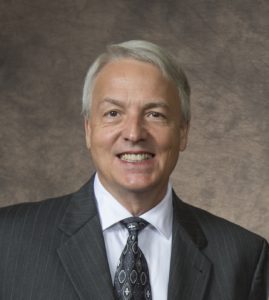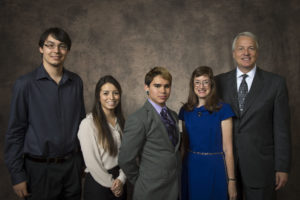 This article originally appeared in the College of Natural Sciences’ Elements magazine. Read the full issue here.
This article originally appeared in the College of Natural Sciences’ Elements magazine. Read the full issue here.
In 1970, a freshman from Illinois arrived on the Colorado State University campus with a plan: to study computers.
At the time, CSU was one of just a handful of schools in the country that offered courses in computer science. Throw in a great campus – and being far from home – and Tom Heidenfelder was sold.
Since then, he has spent decades in the computer industry, rising from programmer to quality tester to consultant, using his acumen – and unfailing attention to detail – to help major companies, including Blue Cross Blue Shield, CVS, and U.S. Cellular, to improve their systems. Thanks to his early training at CSU, he says, “I’ve had a very rich career. My favorite work is online, real-time systems, which are much more challenging.” And in the industry, those have certainly not been in short supply.
Punch card perfectionism
When Heidenfelder started college, however, there were not a lot of real-time systems to learn on at CSU. In fact, there was only one computer. On the entire campus. “It was a monstrous thing, in the basement of the Engineering Building,” he recalls. It was a CDC 6400, and, yes, it ran on punch cards. “We would write up a program, punch it onto cards, and run it for class,” he says.
These cards, like any keyed programming today, demanded perfection. And that is a quality Heidenfelder possesses in abundance. “He’s very, very meticulous,” says his wife, Randy Heidenfelder, honorary Ram and real estate lawyer. “He researches things very thoroughly. If he says it’s ‘x,’ it’s ‘x.’”
As computers and systems grew in complexity, Heidenfelder never lost sight of the goal of those early punch card programming days: to get the system to work – and work well. One of the biggest challenges he faced in his field was convincing others of the importance of excellence. Today, in the era of ad infinitum bug fixes and version updates, he still prefers to create a product that works as it should – the first time around.
Evolution of an industry
When Heidenfelder arrived at CSU, however, he was not on track to receive a computer science degree. Computer science, in fact, didn’t have its own department or degrees then. It was housed in the mathematics department. But Heidenfelder’s timing was impeccable. During his time in the College of Natural Sciences, the computer science field nationwide was gaining steam, and the area of study went from a handful of courses, to its own section in the math department to, at last, becoming its own department. And just in the nick of time. Heidenfelder was a member of one of the first CSU classes to receive a Bachelor of Science in computer science
“CSU prepared me wonderfully for a career,” he says. “I was able to step into my first couple of jobs and be competent almost from day one.” After a four-year post with the Air Force, he jumped right into computing, first getting a job at ACCO, the office supply company, where he was a programmer. From there, he rose quickly, moving on to Abbot Laboratories, then to the Boise Corporation, and finally to Galmont Consulting, where he was a senior consultant, until retiring in 2014. “Logic and programming concepts I learned at CSU transferred easily as the computer industry evolved,” he says.
Growing Support
Grateful for the strong foundations he received in computer science while an undergraduate, Heidenfelder has served for years on the Department of Computer Science’s Industrial Advisory Board. The group, composed of alumni and industry representatives, provides insight into how current students can be best prepared to enter the workforce – and helps the department acquire the latest equipment so that students are up to speed and can jump right in after graduation.
Tom and Randy Heidenfelder know, however, that for many students, college is filled with financial strains. The two, who met in high school in a suburb of Chicago, appreciate their supportive families and science-minded high school (where they got to encounter lasers and early computers). But they recognize that many students are not so fortunate. And that is why they created scholarship funds for the College of Natural Sciences. “I feel honored to know so many great people at CSU who make a difference in many lives,” Tom Heidenfelder says. “How can you not ‘give back’ to such a caring institution?”
About the Aspen Scholarship Fund
 The Colorado landscape continues to inspire Tom and Randy Heidenfelder. That is why they named one of their scholarship funds after the aspen tree. As they note, “the aspen tree starts with a single seed and develops into a broad colony that grows and nurtures many trees that survive for many years.” They hope the scholarship will act as a “seed to create a long-lived, broad base of financial support to help many students grow.” This growth in turn, “will strengthen and grow the efforts by the college and the sciences.” “These are smart kids,” says Randy Heidenfelder. “We need this as a country. We need smart people.”
The Colorado landscape continues to inspire Tom and Randy Heidenfelder. That is why they named one of their scholarship funds after the aspen tree. As they note, “the aspen tree starts with a single seed and develops into a broad colony that grows and nurtures many trees that survive for many years.” They hope the scholarship will act as a “seed to create a long-lived, broad base of financial support to help many students grow.” This growth in turn, “will strengthen and grow the efforts by the college and the sciences.” “These are smart kids,” says Randy Heidenfelder. “We need this as a country. We need smart people.”